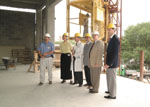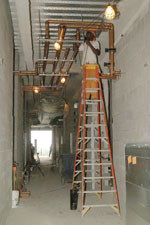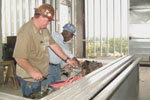Research focus sharper as CRI takes shape
by Heather MurphyPublic Relations
As the Children’s Research Institute (CRI) takes shape, the concept of a center dedicated to the research of childhood disease becomes a reality.
 From
right, Drs. Ray Greenberg, Roger Markwald, Inderjit Singh, Jerry Reves,
and Peggy Schachte listen as Dwayne McMillan explains the next step in
the construction process of the new Children's Research Insititute. The
adminstrators were given a tour of the facility's second floor July 10,
and like workers throughout the building, were required to wear hard hats.
From
right, Drs. Ray Greenberg, Roger Markwald, Inderjit Singh, Jerry Reves,
and Peggy Schachte listen as Dwayne McMillan explains the next step in
the construction process of the new Children's Research Insititute. The
adminstrators were given a tour of the facility's second floor July 10,
and like workers throughout the building, were required to wear hard hats.
Born to continue the MUSC Children’s Hospital’s national forefront status and to help strengthen the hospital’s clinical services, the CRI remains on schedule for its summer 2004 opening, with the first floor of the Basic Science Building (BSB) to open its renovated doors around September of this year.
Ray Greenberg, M.D., Ph.D., MUSC president; Inderjit Singh, Ph.D., Pediatrics; Roger Markwald, Ph.D., Cell Biology and Anatomy; Lyndon Key, M.D., Pediatrics chairman; Jerry Reves, M.D., College of Medicine dean and vice president for medical affairs; and Peggy Schachte, Research Development director, toured the facility with Dwayne McMillan, MUSC Construction Inspector, July 10.
 Renovating
several areas of the Basic Science Building was necessary to accommodate
the CRI.
Renovating
several areas of the Basic Science Building was necessary to accommodate
the CRI.
What McMillan calls a monumental staircase cascades into the center of the first floor BSB lobby, waiting for its glass and steel handrails.
Brand new stainless steel elevators anticipate hordes of students and researchers. The return of the BSB food court is up for debate, possibly near the back of the building, while the finishing touches are put on electrical wiring.
The 121,000-square-foot CRI facility will be the largest and most comprehensive of its kind in the Carolinas and will provide space dedicated to discovering causes and cures for illnesses affecting children.
While official assignment of space has not been made for the second through sixth floors, the seventh floor will house research animals and associated labs.
Each floor will encompass six offices and on every floor but the second and seventh, large conference rooms will gaze towards the new Cooper River Bridge and the west side of town.
 Dwayne
McMillan describes progress on air and water systems on the second floor
of the CRI to Drs. Key, left, Markwald and Singh.
Dwayne
McMillan describes progress on air and water systems on the second floor
of the CRI to Drs. Key, left, Markwald and Singh.
But this building is more than well-designed offices, lobbies, and conference
areas.
“In the past, laboratories were assigned to individuals,” Key said.
“These new labs will be assigned based on themes so that as projects ebb
and flow, the work and research space can accommodate various types of
studies and research.”
So far, themes discussed for research in the CRI include cardio/neuro biology, juvenile diabetes, bone research, stem cell biology, cancer, blood disorders, multiple sclerosis, pulmonary problems, and learning disabilities.
According to Key, the open lab layout allows physicians and scientists the ability to collaborate across disciplines. These laboratory assignments are subject to approval by the CRI Oversight Committee, comprised of seven individuals appointed by the Pediatrics Department chair (3), College of Medicine dean (2), and the provost (2).
“This facility will bring together clinical science and basic science in such a way that research, knowledge, and understanding of illnesses will move faster from the bench to the bed and vice versa,” Key said.
 Many
benefits are associated with the CRI, including the top physicians and
research faculty it will draw, the edge it will provide investigators competing
for funding and grants, access to more technology and facilities, and the
ability to translate research findings quickly to enhance patient care
in the Children’s Hospital.
Many
benefits are associated with the CRI, including the top physicians and
research faculty it will draw, the edge it will provide investigators competing
for funding and grants, access to more technology and facilities, and the
ability to translate research findings quickly to enhance patient care
in the Children’s Hospital.
Recently, Schachte’s office received good news about a construction grant application to the National Institutes of Health, indicating the opportunity for more federal funds to go towards the CRI.
“Our score is considered outstanding by anyone’s standards,” Schachte said. “We should have a better idea of the amount of funding and all the details by September 30. This grant essentially releases monies tied up in bricks and mortar for other necessities like freezers, furniture, refrigerators, and bench top instruments.”
 Schachte
credited the grant application’s success to teamwork on the part of MUSC
and T.H. Chang of SRA, Inc., who wrote the space program and design portion
of the proposal. Singh, Key and Markwald spearheaded the scientific portions
of the application, centered on developmental cardiovascular biology and
neurogenetics.
Schachte
credited the grant application’s success to teamwork on the part of MUSC
and T.H. Chang of SRA, Inc., who wrote the space program and design portion
of the proposal. Singh, Key and Markwald spearheaded the scientific portions
of the application, centered on developmental cardiovascular biology and
neurogenetics.
“Putting together a CO6 grant for renovations or new construction is
a highly technical and complicated process,” she said.
Catalyst Online is published weekly, updated as
needed and improved from time to time by the MUSC Office of Public Relations
for the faculty, employees and students of the Medical University of South
Carolina. Catalyst Online editor, Kim Draughn, can be reached at 792-4107
or by email, catalyst@musc.edu. Editorial copy can be submitted to Catalyst
Online and to The Catalyst in print by fax, 792-6723, or by email to petersnd@musc.edu
or catalyst@musc.edu. To place an ad in The Catalyst hardcopy, call Community
Press at 849-1778.